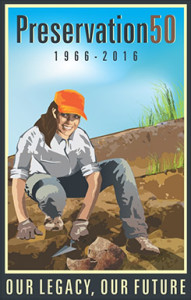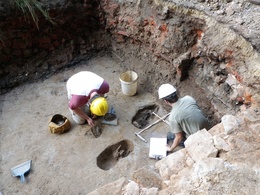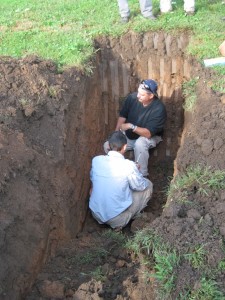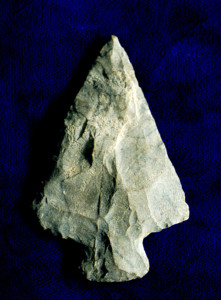by Joe Baker, PennDOT Cultural Resources Program
On a lovely morning in early autumn, I arrive at an old farm along the Susquehanna River to find Dr Frank Vento in his natural element. That is to say, he is squatting down at the bottom of backhoe trench some eight feet deep, carefully examining the many layers of flood-deposited sediment left behind by the great river. Frank is a geomorphologist: a geologist and archaeologist whose specialty is the formation of floodplains, terraces, and other kinds of landforms created by the interaction of climate, gravity, water, wind, and sometimes, humans. Frank is down there looking for something, and as I walk up to the edge of the trench, he finds it.
“Hah! I knew it!”
He extracts a stone spear point from the wall of the trench some 3 feet or so below the ground surface and hands it up to me. It has the distinctive shape of a type of point archaeologists call a Susquehanna Broadspear. It was dropped there by its former owner roughly 3000 years ago, and sealed in-situ by centuries of flooding.
While Frank and I both chuckle at his act of predictive bravura, the discovery isn’t just dumb luck. Frank suspected the point might be right where he found it, thanks in part to nearly 50 years of archaeology done in compliance with one of America’s most significant Federal preservation laws.
 When the National Historic Preservation Act (NHPA) turns 50 years old next year, America will have a great record of accomplishment to celebrate. An important part of that record is the role the act, specifically Section 106, has played in American archaeology. Since Section 106 directs all federally funded and/or permitted projects to consider the effects they might have on significant historic properties, including archaeological sites, half a century of compliance with the NHPA has produced the greatest advances in our understanding of the buried past since the infancy of American archaeology in the early 19th century. Some of the most important American sites, complete cultural histories, the complexities of vanished societies, and unimaginable advances in field and analytical methods have all been discovered and refined as a result of compliance with the law.
When the National Historic Preservation Act (NHPA) turns 50 years old next year, America will have a great record of accomplishment to celebrate. An important part of that record is the role the act, specifically Section 106, has played in American archaeology. Since Section 106 directs all federally funded and/or permitted projects to consider the effects they might have on significant historic properties, including archaeological sites, half a century of compliance with the NHPA has produced the greatest advances in our understanding of the buried past since the infancy of American archaeology in the early 19th century. Some of the most important American sites, complete cultural histories, the complexities of vanished societies, and unimaginable advances in field and analytical methods have all been discovered and refined as a result of compliance with the law.
Ironically, while some of the best and most important American archaeology has come from Section 106, the average American taxpayer has almost never heard of it. The pressures of project schedules and the narrow interests of both archaeologists and project sponsors has generally restricted the results of what is known as Compliance Archaeology or Cultural Resource Management (CRM) to dense and highly technical reports with very limited distribution. Most taxpayers never see or hear about the results of the thousands of compliance projects they ultimately pay for. A recent grassroots initiative by CRM practitioners aims to change that.
The Making Archaeology Public initiative or MAP was initiated by Dr. Lynne Sebastian. MAP’s goals focus on introducing American citizens to the groundbreaking archaeological discoveries that have come from half a century of NHPA compliance. The primary vehicle for delivering this message will be a series of 50 short films hosted on-line by the Archaeology Channel that highlight the most important achievements of compliance archaeology in each state.
The area that surrounds Interstate 95 as it passes through the city of Philadelphia is mostly industrial, a gritty 20th century legacy of old factories and brownfields. It’s not a terribly romantic or scenic landscape, but it has a secret, kept for centuries, that has been uncovered by compliance archaeology.
Archaeologists working ahead of the planned widening and improvement of I-95 have been conducting excavations there for the last several years, and what they found has helped redefine the history of one of the largest and oldest cities in the country. Buried deep beneath yards of rubble, concrete, trash and cinders they have encountered the perfectly preserved remains of some of the old city’s early 19th century industries, including a tannery and a glass manufactory. They have exposed the yards of 19th and 18th century homes and businesses. They have even encountered the habitations and campsites of the Pre-Contact inhabitants of what would be Philadelphia. All of these old landscapes, with all they have to tell us about the history and prehistory of this great city, have revealed things about Philadelphia’s past that were long forgotten or that we never knew. They are a treasure trove as scientifically and historically significant in their way as a Southwestern Pueblo or an Egyptian pyramid.
Before this compliance archaeology project, the busy day-to-day life of modern Philadelphia went on at street level many feet above this hidden world. Nobody even suspected it was there.

Field frew from AECOM excavating a site along I-95 in the Fishtown neighborhood of Philadelphia. Courtesy of PennDOT.
In Pennsylvania, the focus of the MAP initiative will help explain how Dr. Vento knew that broadspear would be there and how the Philadelphia archaeologists suspected there was more to the urban landscape than meets the eye. Pennsylvania is drained by very old Appalachian rivers with very deep and stable floodplains, and contains great urban centers like Pittsburgh and Philadelphia with long histories and layer upon layer of superimposed landscapes. The MAP theme from Pennsylvania is tentatively entitled Digging Deep: Buried Landscapes of Prehistoric and Historic Pennsylvania. It will tell the story of the great depths explored by compliance archaeologists in the Keystone State, and the amazingly well preserved record of human land use they have found here. It’s a story we could never tell without the half century of research conducted as part of Federal compliance with the National Historic Preservation Act, and it’s a legacy all Pennsylvanians can be proud of.
A committee chaired by Angela Jaillet-Wentling of GAI Consultants in Pittsburgh is coordinating the production of Pennsylvania’s contribution to MAP. The committee is still gathering information and ideas from across the Commonwealth’s archaeological and preservation communities, and will be sorting and consolidating that information this summer. A final version of the MAP video is expected by early 2016.
If you have questions about or ideas to contribute to the effort, you can email Angela at A.Jaillet-Wentling@gaiconsultants.com . We look forward to hearing from you!
Joe Baker is an archaeologist, writer and editor working at PennDOT’s central office. He has been doing these things for three federal agencies and three state agencies since 1979. He has a Bachelors’ degree from Penn State and an MA from the University of Montana. Through no fault of his own he has served in various capacities for a number of professional and non-profit organizations, most recently TRB, but has so far successfully avoided leadership positions in any of them. He is interested in educating and encouraging young professionals in CRM and in Pre-Contact and Historic archaeology. He has more avocational interests than is really healthy, and tries not to take himself too seriously.
Comment Policy
PHMC welcomes and encourages topic-related comments on this blog. PHMC reserves the right to remove comments that in PHMC’s discretion do not follow participation guidelines.
Commenters and Comments shall be related to the blog post topic and respectful of others who use this site.
Commenters and Comments shall not: use language that is offensive, inflammatory or provocative (this includes, but is not limited to, using profanity, obscene, or vulgar comments); disparage other commenters or people; condone illegal activity; identify the location of known or suspected archeological sites; post personal information in comments such as addresses, phone numbers, e-mail addresses or other contact details, which may relate to you or other individuals; impersonate or falsely claim to represent a person or an organization; make any commercial endorsement or promotion of any product, service or publication.
If you would like to comment on other topics not related to this blog post but related to PHMC, please fill out the PHMC Contact Us Form.




The article says, “That is to say, he is squatting down at the bottom of backhoe trench some eight feet deep.” the photo shows a trench without shoring. OSHA 1926.652 has requirements for shoring depending on the soil type and trench depth. It appears that a eight foot deep trench in alluvial soil should require shoring.
Mr Linderman: Thank you so much for your comment.
You’re correct. An 8 foot deep trench in would indeed require shoring or stepping per Section V, Chapter 2 of the OSHA technical manual. Please pardon the literary license but the excavation in the image is not the one described in the text (sorry, I didn’t have a photo of that one). The depicted project was on the main stem of the Susquehanna, in the Type A well-consolidated alluvial soils you typically encounter there. In such a location, OSHA requirements allow for a .75/1 slope before shoring is required. The excavation pictured is less than 5 feet deep, and about three feet wide, and is gently ramped for access and egress. The camera angle and lens may distort things a bit, but I can vouch for the dimensions and slope because I was there and entered the trench myself. The trench depicted is in compliance with OSHA technical standards, and much more importantly, both of the occupants are safe.
I very much appreciate your concern for their well-being, and I’m sure they do as well! Glad you enjoyed the blog post. JB